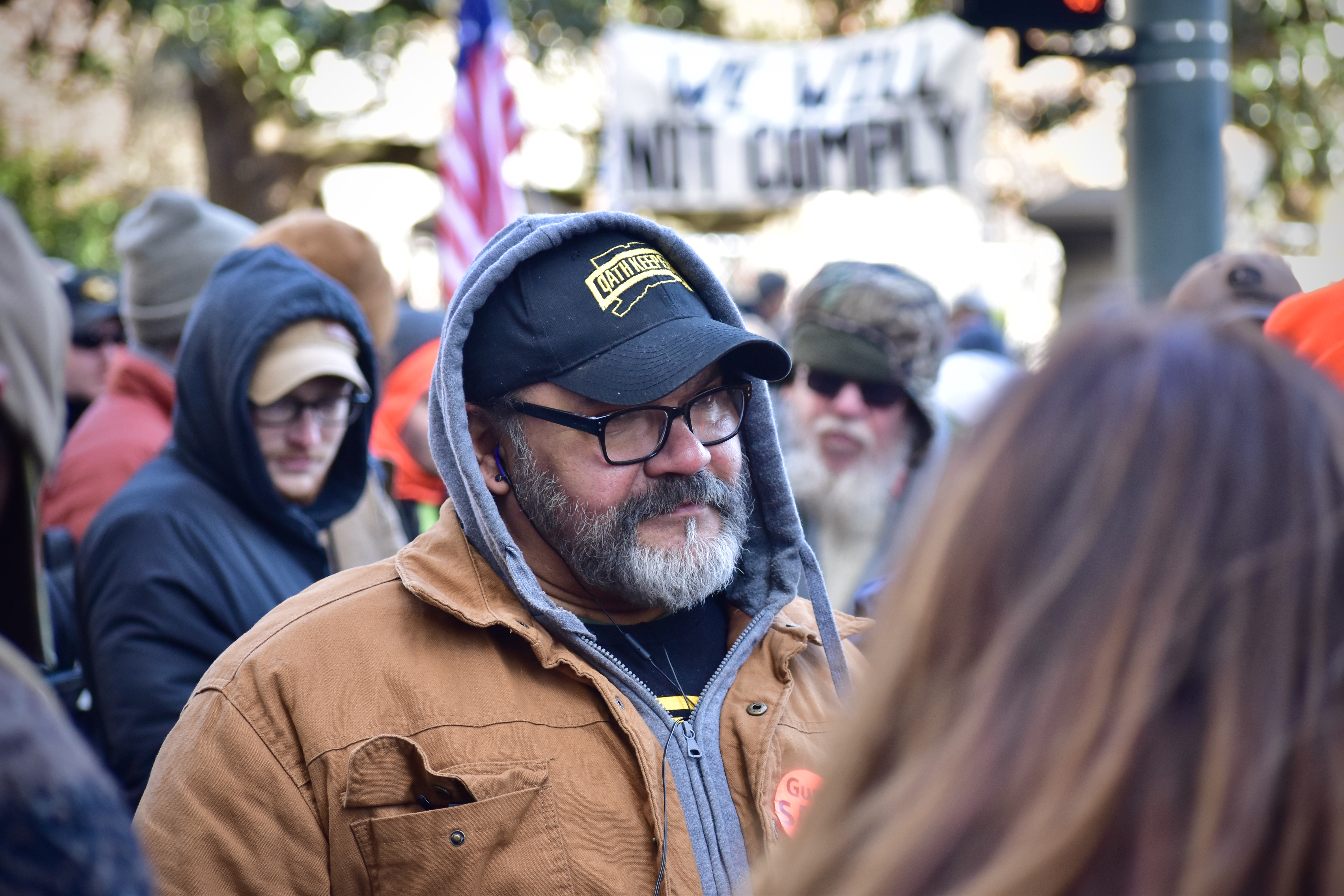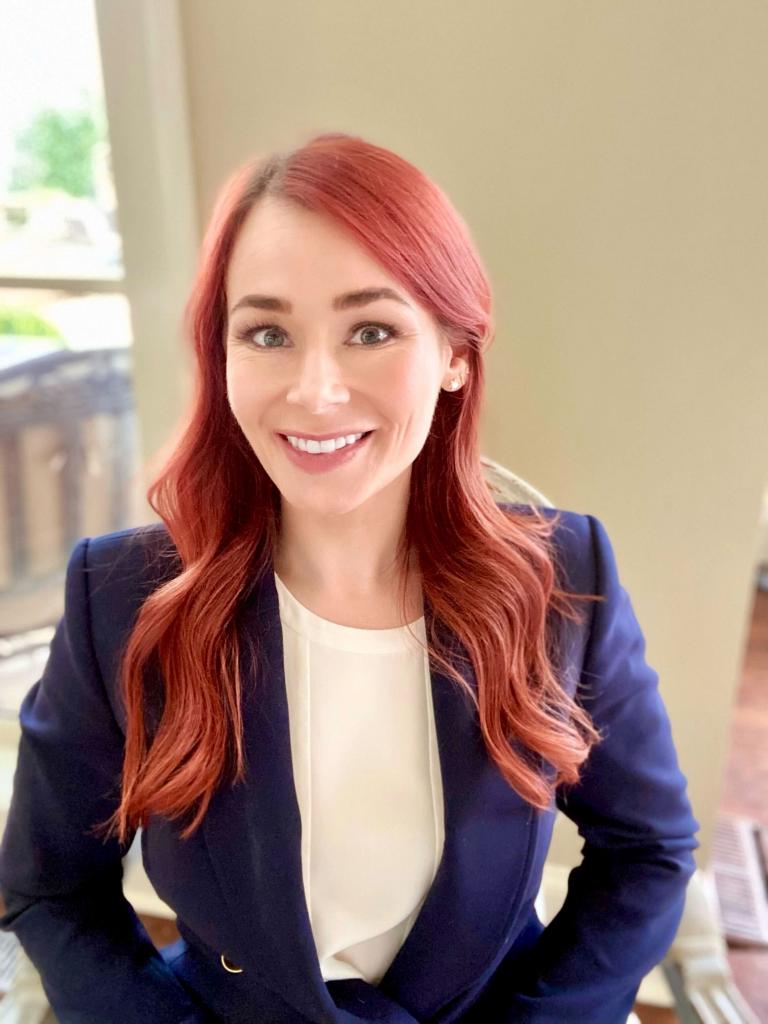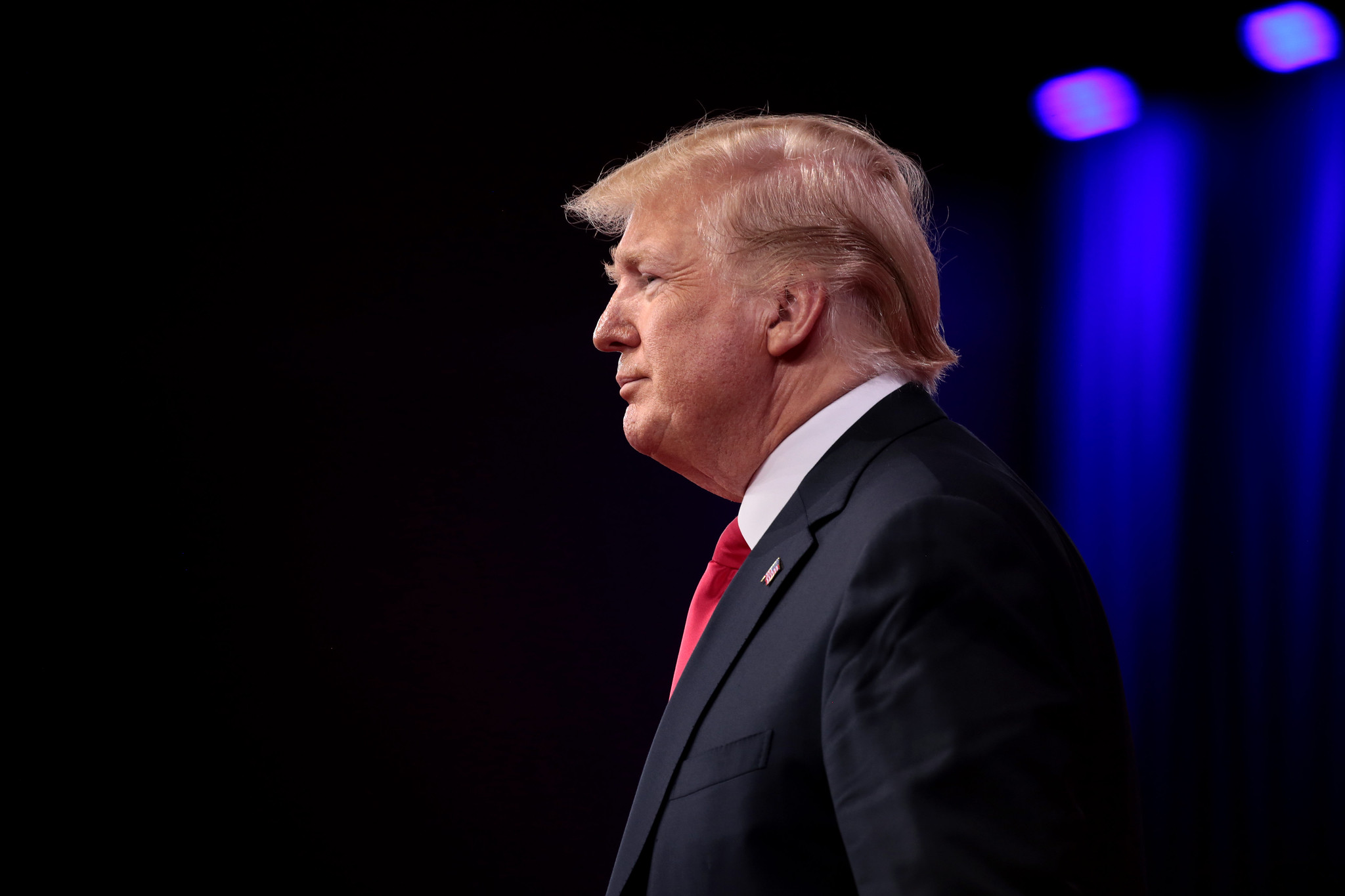Oath Keepers on Trial
A dispatch from the trial of the leader of the Oath Keepers, Stewart Rhodes, and his co-defendants.

Published by The Lawfare Institute
in Cooperation With

It’s around 8:45 a.m. on Monday, Oct. 3, and I’m in an elevator at the E. Barrett Prettyman Courthouse, squeezed between a federal prosecutor and defense counsel for a far-right paramilitary leader.
The elevator isn’t particularly crowded with people. But we’re packed in there anyway, because the prosecutor has luggage.
He is transporting a comically large exhibit poster to Courtroom 23, where the defense attorney’s client, Elmer Stewart Rhodes III, is set to stand trial for seditious conspiracy.
As we ascend to the fourth floor, the prosecutor looks over at his opposing counsel and gestures toward the exhibit poster, which appears to be a kind of “Who’s Who” of right-wing insurrectionists—a visual aid to help jurors remember the names, faces, and connections between various conspirators involved in the Jan. 6 attack on the Capitol building.
I spot a photo of Rhodes near the top of the exhibit.
The prosecutor taps the poster. “We’ve got our secret evidence right here,” he jokes.
“That gonna be what wins it?” the defense attorney retorts.
I’ve been in the courthouse for three hours already.
It was still dark outside when I arrived earlier that morning for opening arguments in the Oath Keepers trial.
While more than 880 people have been charged with crimes related to the Jan. 6 mob at the Capitol building, this Oath Keepers case has emerged as the most complex and high profile to date. It involves the stiffest charges—not just conspiracy but seditious conspiracy, which is the baddest-ass kind of conspiracy you can be charged with. It involves Oath Keepers, who along with Proud Boys, are the most organized group involved in the insurrection. And it involves a lot of co-defendants, five in this trial alone—including the Oath Keeper-in-Chief, Yale Law School graduate Rhodes.
Part of the complexity in the case stems from the nature of the most serious charge leveled against the co-defendants. Seditious conspiracy at its core requires the government to prove not merely that the defendants conspired to do something unlawful, but that they conspired to use force “to resist some positive assertion of authority by the government.” If convicted, Rhodes and his brethren could face up to 20 years in prison on that charge alone.
Now, at 9:13 a.m., we all rise as U.S. District Judge Amit Mehta enters the room. As a first order of business, he notes that there are several outstanding motions to discuss before the jury joins us in Courtroom 23.
He starts with a motion from defendant Kelly Meggs, who filed an eleventh-hour motion for a bench trial—a trial decided by a judge rather than a jury—just last night. “Does the government consent to the bench trial of Mr. Meggs?” Mehta asks. Citing the Supreme Court’s decision in Patton v. United States, the government notes the “public interest” in a jury trial. After Mehta presses for a clear “yes” or “no” answer, the government says it would “defer to the court” on the appropriateness of a bench trial. Mehta seems annoyed with the noncommittal nature of this reply, but he’s prepared to rule from the bench. He denies the motion.
He moves on to the defendants’ joint motion to transfer the venue from the District of Columbia to a judicial district in Virginia. Like their earlier requests to transfer venue, the latest motion argues that the defendants’ rights to an impartial jury will be violated if the trial remains in D.C., where “the latent bias” of the jury pool is “obvious.” The defendants have raised this issue before, as Roger Parloff has detailed on this site, and Judge Mehta still isn’t buying it. Denying the motion, he defends the impartiality of the jury, proclaiming he has “no fear” jury members will follow the court’s instructions to avoid media about the trial. “My sense is this is a very diligent group who will abide by the court’s instructions,” he says.
Continuing the trend, Mehta next rejects Meggs’s request to depose Col. John Siemens. In a motion filed over the weekend, Meggs contended that Siemens’s testimony could “provide significant background concerning the provision of security by the Oath Keepers at various events dating back to 2017.” In turn, that would corroborate the assertion that Oath Keepers had long provided security services prior to the events of Jan 6.
But Mehta is skeptical of the uniqueness of Siemens’s testimony—and he’s certainly not willing to delay the trial for it. “I am quite confident that there will be ample testimony in this case about the Oath Keepers’ provision of security,” he says. While denying any postponement of the trial, he leaves open the possibility of ordering a deposition.
Finally, Mehta discusses a batch of defense motions involving requests to limit what the prosecution can say during opening arguments and during its case in chief. Most notably, counsel for Rhodes asks the government not to use certain terms to describe the Oath Keepers: “paramilitary,” “white nationalist,” “anti-government,” “militia,” and so on. Of those terms, however, the government stresses that “militia” is the only one it plans to use. Counsel for Rhodes argues that would be improper because the Oath Keepers, as an organization, never held itself out to be “a militia.” But Mehta can’t understand how to square that request with the legal theory of the defense. As he understands it, he explains, the defense intends to argue that the Oath Keepers honestly believed they would be called on to act as a presidentially authorized militia on Jan. 6. As with each of the preceding motions, he denies this one, too.
With housekeeping matters now behind him, Mehta announces that he’s ready to bring in the jury. Sixteen individuals enter the courtroom and file into the jury box—12 jurors, four alternates. Mehta, putting on his best elementary school teacher voice, spends a few minutes providing instructions to the jurors. Then, finally, he invites the government to the lectern to give its preview of the evidence it expects to present over the next few weeks.
Assistant U.S. Attorney Jeffrey Nestler strides toward the wooden lectern positioned in front of the jury box. Directing his gaze toward the jury, he begins: “Ever since our government transferred power from George Washington to John Adams in 1797, we have had a core custom of routine and peaceful transfer of power.” But the defendants in this case, he continues, “tried to change that history” by stopping the transfer of power from Donald Trump to Joe Biden. “They concocted an armed rebellion to shatter the bedrock of American democracy,” he charges.
Nestler then introduces the jury to each of the defendants charged in the case, beginning with Rhodes. Rhodes is easily recognizable, he says, because of his eye patch (he lost that eye in a gun accident in 1993) and proclivity for cowboy hats. Noting that Rhodes has an “impressive pedigree,” Nestler rattles off a list of Rhodes’s accomplishments. It’s not just Yale Law School. He was an army paratrooper and a congressional staffer too. He explains how Rhodes founded Oath Keepers, a name that derives from soldiers’ oaths to “defend the Constitution against all enemies.” But Rhodes, he says, “perverts the Constitution.”
Next, Nestler introduces Rhodes’s co-defendants. There’s Kelly Meggs, the 6-foot-4 leader of the Oath Keepers chapter in Florida. Then there’s Meggs’s right-hand man in the Florida chapter, Kenneth Harrelson. Next is Jessica Watkins, the leader of the Oath Keepers in Ohio and, like all the other defendants except for Meggs, a military veteran. Finally, he ends with Thomas Caldwell, an Oath Keepers “affiliate” who was involved with coordinating the group’s so-called quick reaction force on Jan. 6. According to Nestler, Caldwell, a navy veteran, planned to use boats to ferry firearms across the Potomac River from their station in Arlington into the District of Columbia.
Having introduced the key players on trial, Nestler provides an overview of the conspiracy. He describes how, on Jan. 6, 2021, at around 2:35 p.m., a crowd on the east-side steps of the Capitol parted as a group of 14 people in combat gear, moving in “stacked” military formation, marched up the doors into the building. This formation, Nestler said, was led by Meggs, Harrelson, and Watkins.
After the stacked formation pushed past police to breach the Capitol, Nestler says, the group split up: Meggs led a group of seven toward the House, while Watkins led a group of seven toward the Senate. It’s one example, Nestler argues, of how the Oath Keepers defendants used their military or tactical experience to plan Jan. 6.
“They were not there to help; they were there to attack,” Nestler continues. He displays a video of Watkins from inside the Capitol, as she attempts to push past police into the Senate chamber. “Push, push, push … get in there … they can’t hold us,” Watkins hollers. Nestler also notes that, on the day of the attack, Meggs wore an arm patch bearing the slogan “I don’t believe in anything. I’m just here for the violence.”
But simply entering the building “wasn’t enough for these defendants,” Nestler declares. They needed to get to the senators, he says. Describing Meggs’s “keen interest” in Speaker of the House Nancy Pelosi, Nestler alleges that Meggs said that “Pelosi would be first” if he went on a killing spree over the election results. And, later, he displays a text message sent by Caldwell in the aftermath of Jan. 6: “If we had guns I guarantee we would have killed 100 politicians but they ran off and were spirited away through their underground tunnels, like rats.”
Nestler shifts focus to the whereabouts of the Oath Keepers’ leader on Jan. 6. While Meggs, Watkins, Harrelson, and other co-conspirators forced their way into the Capitol, he explains, Rhodes stayed outside. But he remained in constant communication with his lieutenants and troops in the Capitol. “He was like a general, surveying his troops on the battlefield,” Nestler says. Among the many messages Rhodes sent to Oath Keepers during the attack: “Members of congress need to be shitting their pants.”
Now Nestler turns back to the events leading up to Jan. 6, beginning in early November 2021. Following Biden’s election win, Nestler contends, Rhodes “kicked into gear.” He details how Rhodes, in the days following the election, instructed followers to prepare for “civil war.” He studied tactics used to overthrow the government of Serbian dictator Slobodan Milosevic; told legions of followers that they would have to “take up arms and fight”; and urged Trump to invoke the Insurrection Act—a law that authorizes the president to deploy the military to enforce federal law—to stop the certification of the election.
As he planned to disrupt the transfer of power by any means necessary, Nestler says, Rhodes used the Insurrection Act as legal cover. As proof of that claim, Nestler plays a clip of Rhodes instructing Oath Keepers to refer to the Insurrection Act because it could provide “legal cover.” According to Nestler, Rhodes thought the act “would give him and his followers plausible deniability.”
In December 2020, Nestler alleges, Rhodes told others that Jan. 6 represented a “hard constitutional deadline” to stop the presidential transition. But as that date drew near and a peaceful transition became “more and more likely,” Rhodes and his co-conspirators grew “more and more desperate.” According to Nestler, Rhodes spent tens of thousands of dollars on firearms and made preparations to store them at a Comfort Inn in Virginia, a state with laws that are more gun-friendly than Washington, D.C. The group’s so-called quick reaction force would be stationed at the hotel, prepared to transport the weapons into D.C.—by boat or otherwise—if needed.
Even after Jan. 6, Nestler continues, Rhodes showed no remorse. He plays a recording dated Jan. 10. “My only regret is that they should have brought rifles,” Rhodes says. “We could have fixed it right then and there.”
Having set out his summation of the facts, Nestler ends by emphasizing the “unbroken tradition” of a peaceful transfer of power in this country. “That unbroken tradition, dating from President Washington to President Abram … [,]” Nestler trails off, seemingly flustered by this momentary slip-up. After a beat, he self-corrects: Adams, he emphasizes. He finishes by asking the jurors to find each of the co-defendants guilty.
After a short break, it’s the defense’s turn to present opening statements. First up is Phillip Linder for Rhodes. Clad in a light gray suit and a bright orange tie, the Texas-based attorney strides to the lectern. “If you didn’t know before today,” he tells the jury, “you’re in one of the most important jury trials in history.”
Speaking with a noticeable Southern accent, Linder declares that the story the jury has heard about the Oath Keepers “from the government and the media” is completely wrong. Rhodes’s conduct might have been “inflammatory,” but it was not “illegal,” he claims.
He appeals to a Bible verse, Proverbs 18:17, which says, “[T]he one who states his case first seems right, until the other comes and examines him.” He implores the jury to “wait ’till you’ve heard the full story” before passing judgment.
Linder promises that the prosecution won’t present any “new” evidence in the case. “Nothing you haven’t seen in the media,” he says. At this, Mehta interjects, instructing Linder to avoid references to media. “It’s not relevant,” he says. When Linder attempts to resume his argument, he alludes to his client’s current incarceration and the serious prison terms faced by the defendants. Mehta, clearly annoyed at this point, again interrupts to tell Linder to avoid those topics.
Moving on, Linder tells the jury that they will hear evidence to support the argument that the Oath Keepers’ plans were “reactive and defensive” only. “Stewart Rhodes meant no harm in the Capitol that day,” he claims. Finally, he reminds the jury, the government bears the burden of proof. “I’m gonna ask you to hold the government to that burden of proof.”
After a lunch break, attorney David Fischer is up at the lectern on behalf of Thomas Caldwell, the supposed coordinator of the Oath Keepers’ quick reaction force. In contrast to Linder’s conversational, even understated, opening earlier this afternoon, Fischer takes a more bombastic approach. He begins by attempting to minimize the role played by Caldwell, asserting that his role was “smaller” than that of other conspirators.
Next, he targets the government’s theory that Rhodes, Caldwell, and others intended the quick reaction force, or QRF, to attack the Capitol on Jan. 6. Let’s talk about what “QRF” stands for, he says. “Quick. REACTION. Force,” he says, pausing between each word for maximum drama. “The verb is not to act; it is to react,” he says. Fischer alleges that the FBI has interviewed “hundreds” of witnesses and that “not one” has suggested that the purpose of the QRF was to attack anything in D.C. That shows, Fischer thinks, that the government’s case is an “Absolute. Abject. Lie. One hundred percent.”
Fischer next accuses the government of “selectively editing” the most outrageous text messages and social media posts from the defendants. But you could do that with anyone, he argues. If I took AOC’s phone, I could cobble …[,]” he starts to say. This prompts a loud “OBJECTION!” from the prosecution. “I’ll withdraw it, I’ll withdraw it,” Fischer responds.
Pressing on, Fischer sets out Caldwell’s version of the facts. He paints a portrait of Caldwell as an elderly, disabled veteran wrongly accused of seditious conspiracy. Fischer’s theory of the case, it seems, is that Thomas Caldwell is the unluckiest man in the world.
As the minutes tick by, he spins a stunning tale of investigative errors. He implies that a photo of Caldwell’s wife, purportedly taken inside the Capitol, could have been Photoshopped. He says Caldwell’s texts about “storming the castle” were quotes from the beloved 1980s film “The Princess Bride.” He complains that the supposed “pre-strike reconnaissance” mission carried out by Caldwell on Jan. 5 was simply an effort to catalogue the number of Porta Pottys available around the Capitol. And when Caldwell said, “We stormed the barriers”? He was referring to the crowd in general. “Mr. Caldwell couldn’t storm his way out of a paper bag, ladies and gentleman.” After imploring the jury to exonerate his client, Fischer strides back to his seat.
Now Jonathan Crisp, for Watkins, rises to provide his argument. Speaking slowly and quietly, Crisp reminds the jury that “context matters.” He describes why Watkins joined the Oath Keepers. She’s a “protest junkie,” he says, and a medic by trade. “She wanted to help people.” He notes that Watkins is also a transgender woman who “never felt like she fit in.” That could explain Watkins involvement with the Oath Keepers, as well as her conduct on Jan. 6.
Like Linder and Fischer, Crisp challenges the notion that the QRF planned to attack the Capitol. “The whole QRF thing that they want to paint as an overthrow unit wasn’t at all,” he asserts. Instead, he says, deployment of the QRF depended on a “condition precedent”: Trump invoking the Insurrection Act. But that never happened, he reminds the jury. Finally, he discusses Watkins’s willingness to work with investigators, noting that she freely and willingly spoke to the FBI several times and offered to provide access to her accounts. “These are not the actions of someone trying to overthrow the government,” Crisp contends.
After Crisp returns to his seat, Judge Mehta asks if the attorneys for Meggs and Harrelson intend to provide opening statements. They decline.
And with that, opening arguments in the Oath Keepers trial are a wrap. The poster from the elevator has not been used yet.
Correction: An earlier version of this article mistakenly identified Kelly Meggs as an Army veteran.





